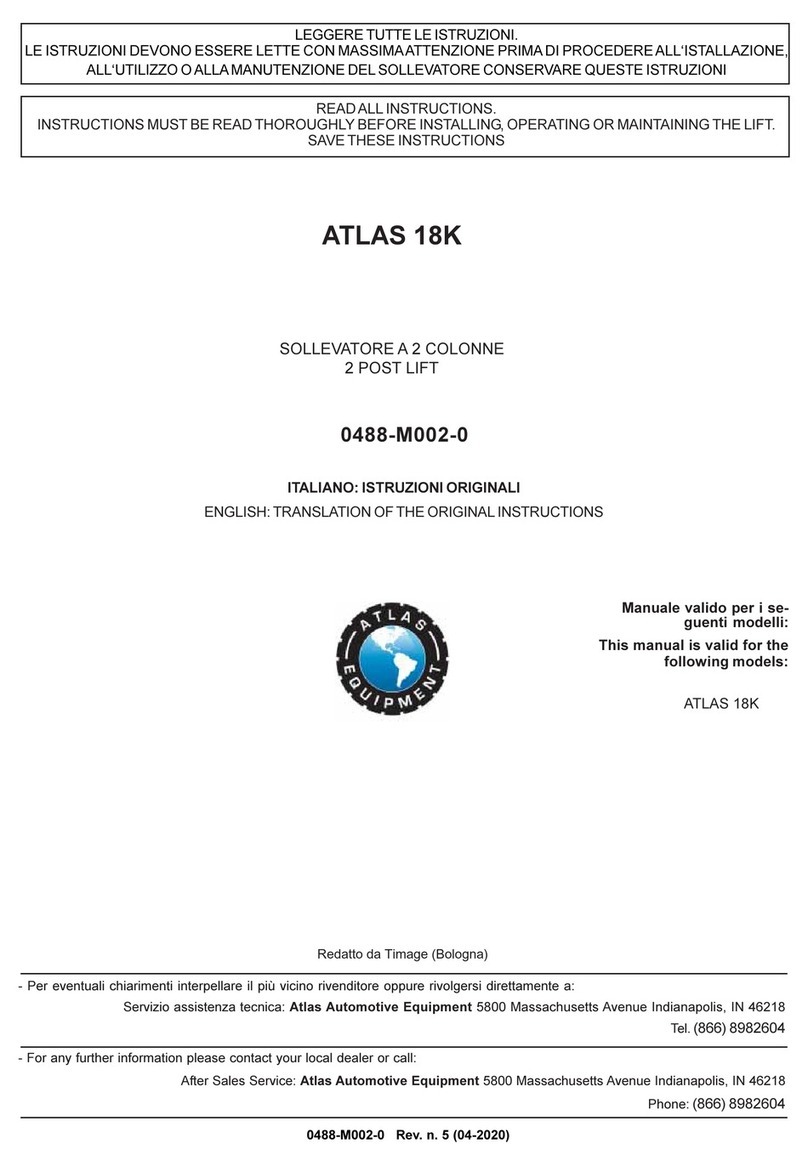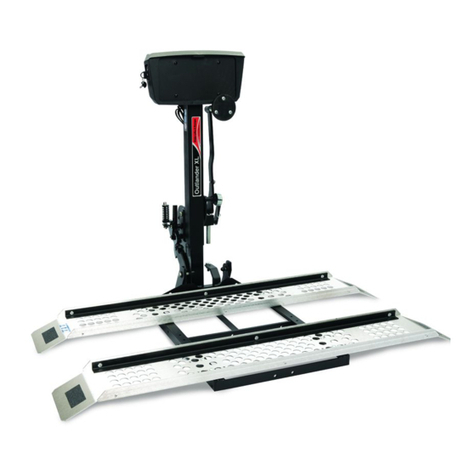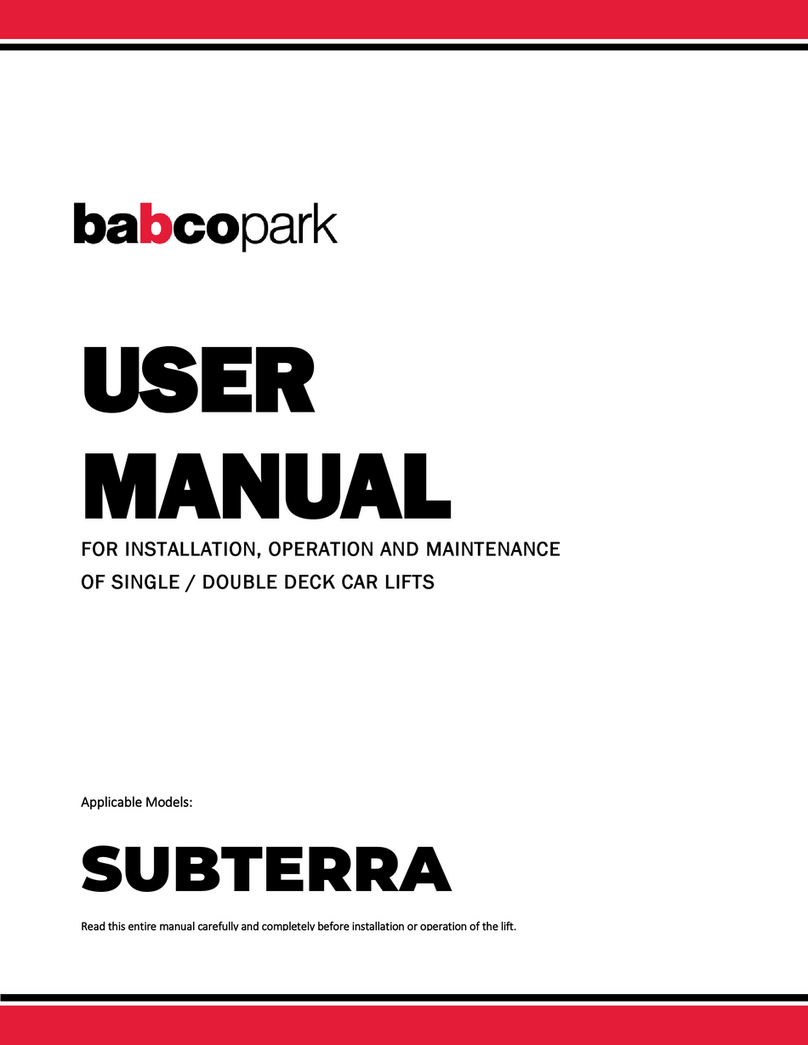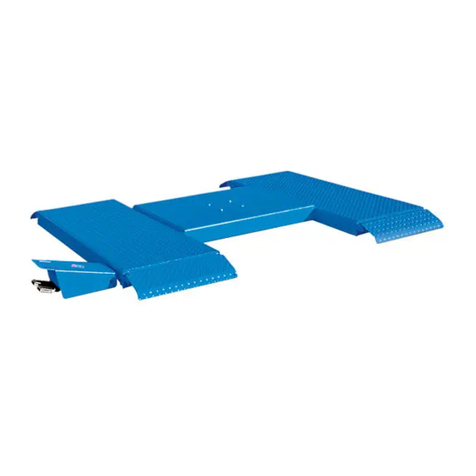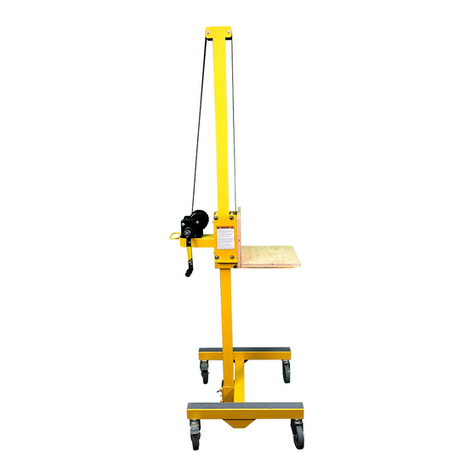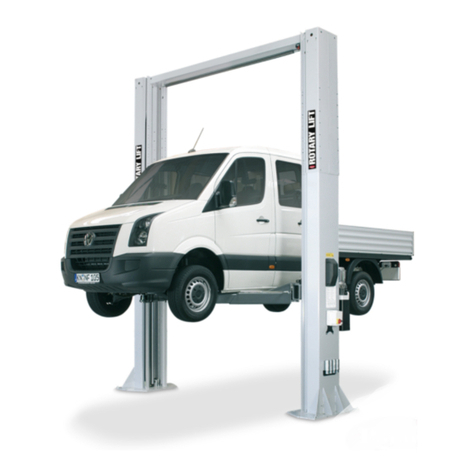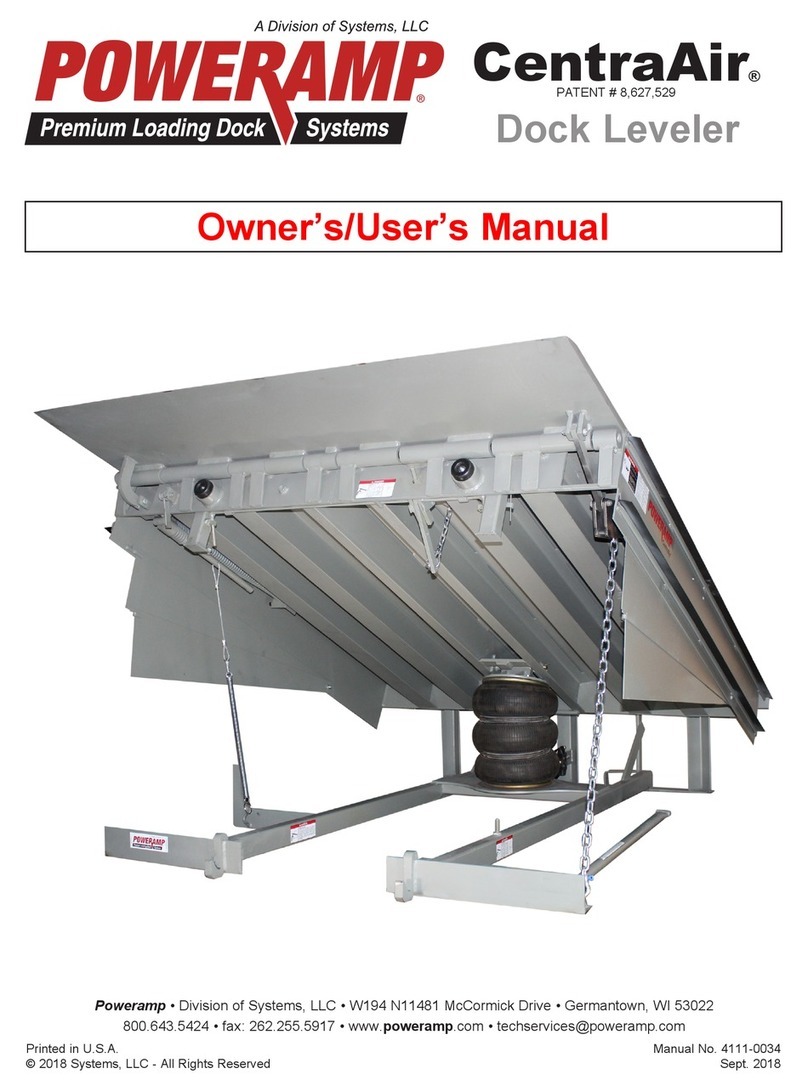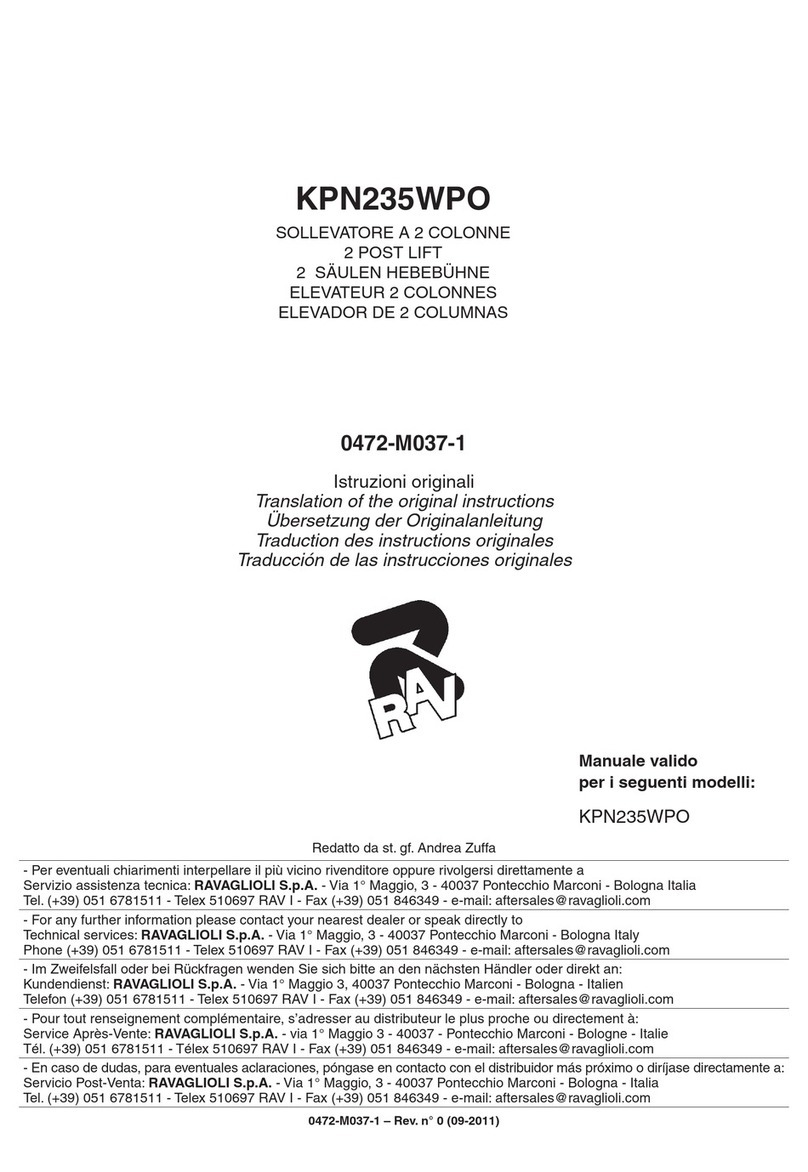J. D. NEUHAUS JDN mini Series Service manual

powered by air!
JDN OPERATION AND ASSEMBLY
INSTRUCTIONS AIR HOISTS
Original Operation and
Assembly Instructions

powered by air!
Page 2
This operation manual edition 8/2010,
covers the following JDN MINI Air Hoists:
It must be read carefully and in its entirety
before operating any MINI air hoist.
For hoists installed in trolleys, refer also to
the JDN Trolleys Operation Manual.
Please enter the Fabr. No. of your
JDN Air Hoist here.
Fabr. No. Fabr. No.
Fabr. No. Fabr. No.
mini 500

powered by air!
Page 3
TABLE OF CONTENTS
Organisational measures . . . . . . . . . . . . . . . . . . 5
Personnel safety . . . . . . . . . . . . . . . . . . . . . . . . 5
Preventing property damage . . . . . . . . . . . . . . . 5
The operation manual . . . . . . . . . . . . . . . . . . . . . 6
Warnings and symbols. . . . . . . . . . . . . . . . . . . . . 6
Designation . . . . . . . . . . . . . . . . . . . . . . . . . . . . 7
Assembly overview . . . . . . . . . . . . . . . . . . . . . . . 8
Product description. . . . . . . . . . . . . . . . . . . . . . . 8
Explosion protection . . . . . . . . . . . . . . . . . . . . . . 9
Intended use. . . . . . . . . . . . . . . . . . . . . . . . . . . 13
Emissions . . . . . . . . . . . . . . . . . . . . . . . . . . . . . 13
Operating conditions . . . . . . . . . . . . . . . . . . . . . 13
Energy requirements . . . . . . . . . . . . . . . . . . . . 15
Principle of operation of
JDN air vane motors . . . . . . . . . . . . . . . . . . . . . 16
Operation without chain box . . . . . . . . . . . . . . . 17
Motor lubrication/operation with service unit . 17
CE marking / declaration of incorporation . . . . . 17
Spare parts. . . . . . . . . . . . . . . . . . . . . . . . . . . . 17
Safe transportation . . . . . . . . . . . . . . . . . . . . . 18
Storage conditions . . . . . . . . . . . . . . . . . . . . . . 18
Unpacking. . . . . . . . . . . . . . . . . . . . . . . . . . . . . 19
Assembly. . . . . . . . . . . . . . . . . . . . . . . . . . . . . . 19
Installing the hoist . . . . . . . . . . . . . . . . . . . . . . 19
Connecting the controls. . . . . . . . . . . . . . . . . . . 20
Connecting to the main air supply. . . . . . . . . . . 21
Lubricants. . . . . . . . . . . . . . . . . . . . . . . . . . . . . 21
Pre-start checks . . . . . . . . . . . . . . . . . . . . . . . . 22
Rules for safe operation
of hoists . . . . . . . . . . . . . . . . . . . . . . . . . . . . . . 23
Controls . . . . . . . . . . . . . . . . . . . . . . . . . . . . . . 26
Emergency stop device . . . . . . . . . . . . . . . . . . . 26
Attaching the load . . . . . . . . . . . . . . . . . . . . . . . 27
Lifting the load . . . . . . . . . . . . . . . . . . . . . . . . . 27
Lowering the load . . . . . . . . . . . . . . . . . . . . . . . 27
Detaching the load . . . . . . . . . . . . . . . . . . . . . . 27
Interrupting working . . . . . . . . . . . . . . . . . . . . 27
Shutting down . . . . . . . . . . . . . . . . . . . . . . . . . 28
Storage . . . . . . . . . . . . . . . . . . . . . . . . . . . . . . . 28
Dismantling . . . . . . . . . . . . . . . . . . . . . . . . . . . 28
Disposal . . . . . . . . . . . . . . . . . . . . . . . . . . . . . . 28
Maintenance and inspection intervals . . . . . . . . 29
Cleaning and care . . . . . . . . . . . . . . . . . . . . . . . 29
Spare parts . . . . . . . . . . . . . . . . . . . . . . . . . . . . 29
Lubricants . . . . . . . . . . . . . . . . . . . . . . . . . . . . . 29
Inspection and repairs . . . . . . . . . . . . . . . . . . . . 29
Instructions on the ˝model for determining
the actual operating time˝ . . . . . . . . . . . . . . . . . 31
Lubricating the chain . . . . . . . . . . . . . . . . . . . . 34
Checking braking function . . . . . . . . . . . . . . . . 34
Checking the direction of movement . . . . . . . . . 34
Checking lifting and lowering limiters . . . . . . . . 34
Checking controls and emergency stop . . . . . . . . 35
Checking the silencer for permeability . . . . . . . 35
Replacing brake discs, brake pistons and vanes
/Motor installation . . . . . . . . . . . . . . . . . . . . . . 36
Adjusting the brake . . . . . . . . . . . . . . . . . . . . . . 36
Checking axial play . . . . . . . . . . . . . . . . . . . . . . 38
Checking and replacing load hook and buffer . . 38
Checking chain . . . . . . . . . . . . . . . . . . . . . . . . . 39
Replacing chain and chain sprocket . . . . . . . . . . 40
Chain box . . . . . . . . . . . . . . . . . . . . . . . . . . . . . 41
Fault table . . . . . . . . . . . . . . . . . . . . . . . . . . . . . 42
Technical data . . . . . . . . . . . . . . . . . . . . . . . . . . 43
Dimensions . . . . . . . . . . . . . . . . . . . . . . . . . . . . 44
Tightening torques . . . . . . . . . . . . . . . . . . . . . . 45
Air flow sheet . . . . . . . . . . . . . . . . . . . . . . . . . . 46
APPENDIX
FAULTS, CAUSE AND REMEDY
MAINTENANCE
TAKING OUT OF OPERATION
OPERATION
INITIAL OPERATION
TRANSPORT AND STORAGE
PRODUCT INFORMATION
SAFETY MEASURES

Please note:
Within the Federal Republic of Germany operators of
air hoists must comply with trade association accident
prevention regulations and rules, as well as state
occupational safety regulations, in particular
BGV A1 accident prevention regulations ˝Principles of
Prevention˝
BGV D8 accident prevention regulations ˝Winches,
Lifting and Pulling Devices˝
BGR 258 trade association regulations ˝Operation of
Load-Carrying Devices Used with Lifting Equipment˝
and, for air hoists installed in trolleys and for the
operation of monorail hoists, additionally with
BGV D6 ˝Accident Prevention Regulations for Cranes˝
in the respective currently applicable version.
Operators must also initiate the prescribed tests
(see also ˝Principles for the Testing of Cranes˝
BGG 905 (ZH 1/27).
To document the tests we recommend the “Inspection
log for cranes” BGG 943 (ZH 1/29) from the trade asso-
ciation.
When operating air hoists in areas with explosive
atmospheres, the operator must comply with the
relevant explosion protection regulations, e.g.
BGR 104 ˝Explosion Protection Regulations˝ and
BGR 132 ˝Prevention of Ignition Hazards due to
Electrostatic Charges˝
In all other countries, the operator shall comply with
local regulations as applicable.
Special regulations may apply when incorporating air
hoists into other installations or using air hoists under
unusual conditions.
powered by air!
Page 4

JDN Hoists are designed in accordance with current
technological standards and accepted safety practice.
Nonetheless, the use of an air hoist may be associated
with risk of injury or fatality to the user or to third
parties or with the risk of damage to the hoist or to
other items, if safety rules are disregarded.
All personnel charged with operating air hoists, must
have read and understood the operation manual, espe-
cially the section entitled ˝Rules for the safe operation
of hoists˝, before commencing work.
This is particularly important for personnel who only
occasionally operate the hoist, e.g. for maintenance or
retrofitting work.
Operators of JDN Hoists are also under obligation to
ensure safe and hazard-free operation. This can be
achieved through the following measures:
keep the operation manuals available at the hoist
operating site,
performing regular training,
Perform regular inspections (at least once annually),
implement an inspection log and make regular
entries,
and regularly check personnel for safety and hazard
awareness during work.
Personnel who operate, maintain, inspect and perform
setting-up work on the hoist must be properly trained
or must receive an introduction from properly trained
personnel, before commencing work.
Due to their technical training and experience, properly
trained personnel have adequate knowledge of hoists.
They are sufficiently familiar with the relevant occupa-
tional safety and accident prevention regulations that
they are able to assess the condition of hoists with
regard to working safety.
Follow the operating instructions for your workplace.
Comply with the accident prevention regulations.
Ensure that you are properly informed regarding
working with hazardous materials.
Follow the safety instructions set out in the
operation manuals.
Operators of JDN Hoists are under obligation to ensure
that entries in the accompanying inspection log are
made properly and regularly.
Comply with the prescribed maintenance intervals.
Only use JDN hoists for work which is described as
intended use.
Observe the operating conditions for JDN Hoists as
described in this manual.
PREVENTING PROPERTY DAMAGE
PERSONNEL SAFETYORGANISATIONAL MEASURES
powered by air!
SAFETY INSTRUCTIONS
Page 5
SAFETY INSTRUCTIONS

This operation manual is intended to help the operator
to become familiar with JDN air hoists and their
intended use.
This operation manual contains important information
for the safe, proper and efficient operation of JDN Air
Hoists. Observance of the manual helps to avoid haz-
ardous situations, to reduce repair costs and downtimes
and to ensure the specified service life of the JDN Air
Hoists.
Safety warnings in this operation manual are classified
in three categories:
DANGER!
Safety warnings, which if not followed can
result in hazard to life and limb, are indicat-
ed by this symbol.
The symbol indicates an immediate danger.
The possible consequences of non-observance
may be severe or even fatal injuries.
CAUTION!
This symbol indicates potentially hazardous
situations. Failure to observe may result in
light injuries.
ATTENTION!
This symbol indicates that failure to follow
the relevant instructions may result in dam-
age to the hoist or other equipment.
WARNINGS AND SYMBOLSTHE OPERATION MANUAL
powered by air!
PRODUCT INFORMATION
Page 6
PRODUCT INFORMATION

The nameplate mounted on the housing cover identifies
the type of JDN Air Hoist and contains all
important rating data.
If you have any questions concerning operation of JDN
Air Hoists, which are not addressed in this operation
manual, please contact us at the following address:
J.D. NEUHAUS GMBH & CO. KG
Windenstraße 2-4
D - 58455 Witten-Heven
Phone +49 2302 208-0
Fax +49 2302 208-286
www.jdn.de
e-mail: info@jdn.de
Example of nameplate on housing cover
LABELLING
powered by air!
PRODUCT INFORMATION
Page 7

MINI series air hoists consist of the
following assemblies:
1Motor
2Gearbox with chain drive
3Controls
4Chain and hook
5Chain box
MINI series JDN Air Hoists are chain air hoists for load-
carrying capacities of 125 kg, 250 kg, 500 kg and 980
kg in the EU version. Outside of the EU the maximum
load-carrying capacity is 1000 kg. All models lift using
a single chain. They are equipped with direct controls
and an EMERGENCY STOP device.
Loads can be moved and positioned with precision.
The highest and lowest load hook position is limited
by buffers (emergency end stop).
DANGER!
Hook travel limit buffers are for emergency
use only, repetitive impact of buffers is not
allowed! Operator must monitor hook travel
to prevent impact of the buffer against the
hoist body.
JDN MINI Air Hoists conform to driving mechanism clas-
sification 1 Bm in accordance with FEM, corresponding
to M3 as per ISO.
The motors for the JDN MINI air hoists are treated dur-
ing installation with a JDN high-performance grease
(Art. No. 11901). This grease enables operation with
oil-free compressed air. It remains effective for an
operating period of approx. 100 hours and should be
renewed after five years, at the latest (see Motor lubri-
cation, page 17). Additional lubrication with oil-bearing
compressed air by means of a service unit with oiler
is possible.
MINI series JDN Air Hoist
PRODUCT DESCRIPTION
ASSEMBLY OVERVIEW
powered by air!
PRODUCT INFORMATION
Page 8
12
4
5
3

The basis for the following information is an expert
statement by the DMT Gas & Fire Division on the use
of JDN Hoists, Trolleys and Crane Systems in explosion-
hazardous areas, based upon European Guideline
94/9/EC1(˝ATEX 100a˝). DMT is accredited with the
testing of devices and protection systems for intended
use in explosion-hazardous areas.
MINI type JDN Air Hoists are category 3 devices for
general industrial use and for use in zone 2 for gases
of explosion group IIA. They are also suitable for use
in zone 22 for dusts, provided that no light metal or
other impact-sensitive dusts are present.
They are designated by II 3 GD IIA T4(X)
ADDITIONAL MARKING ˝X˝
This designation refers to explosion protection details
in the operation manual.
II 3 GD IIA T4(X):
This designation does not permit use in the presence of
light metal or other impact-sensitive dusts, or in the
presence of dusts with glow temperatures below 210° C
or ignition temperatures below 202° C. The permissible
ambient temperature range (Ta) extends from - 20° C to
+ 50° C.
MATERIALS FOR FRICTION AND IMPACT HAZARDS
Impacts between particular materials result in an
increased ignition hazard. This does not apply to
corrosion-resistant steel or cast iron against aluminium,
magnesium or corresponding alloys. It applies in partic-
ular to the presence of rust or of rust film. Rust (also
rust film) formation is possible, especially on the chain
and on the load hook, at the friction points. The follow-
ing holds true for all zones: For the intended use of
hoists it must be ensured that no rust is present at the
above-mentioned friction points and that material
combinations of the above-named light metals with
steel (exception being stainless steel) or cast iron are
not used in the working area of the hoists, at potential
friction, impact or sliding points.
It is thus possible to exclude sparking due to mechani-
cal influences with these material combinations.
The external housing of the service units is made of
aluminium. Therefore the installation position is to be
selected so as to ensure that there is no risk from
impact sparks.
CLEANING PLASTIC SURFACES
Where JDN Air Hoists or JDN Air Winches feature plastic
parts, these surfaces must only be cleaned using a damp
cloth (cleaning cloth with water). This reduces electro-
static charging that can arise due to mechanical friction
at the plastic surface.
DANGER!
Electrostatic charging may occur at the
plastic surfaces, potentially leading to
electrostatic discharge that can ignite
gases and air mixtures.
EXPLOSION PROTECTION
powered by air!
PRODUCT INFORMATION
Page 9

powered by air!
PRODUCT INFORMATION
Page 10
EXPLOSION GROUPS AND TEMPERATURE CLASSES OF THE MOST IMPORTANT GASES AND VAPOURS (-SELECTION)
(in accordance with DIN VDE 01656, Redeker7, Nabert, Schön8, IEC 60079-123and IEC 60079-204)
( ): The measured values for the substances placed in brackets are close to the limit or the next group or class when classified
in the explosion groups or temperature classes. For this reason, they have been included in both.
**: Extremely flammable substances
*1 (Methanol = Methyl alcohol)
Ex group Temperature class
T1 T2 T3 T4 T5 T6
Ignition temperature
> 450° C 450-300° C 300-200° C 200-135° C 135-100° C 100-85° C
Maximum permissible surface temperature of operating facilities
450° C 300° C 200° C 135° C 100° C 85° C
II A Acetone (Ethyl alcohol) n-Amyl alcohol Acetaldehyde
Ammonia (Ethylene glycol) Benzene
Aniline i-Amyl acetate (petrol)
Benzol n-Butane Diesel
Chlorobenzene n-Butyl alcohol Fuel oil
1,2-Dichlorobenzene 1-Butylene n-Hexane
Acetic acid 1,2-Dichloroethane jet fuels
Ethane Di-i-Propyl ether
Ethyl acetate Natural gas
(Ethyl bromide) Acetic anhydride
Ethyl chloride n-Propyl acetate
(Carbon monoxide) (n-Propyl alcohol)
o-Cresol i-Propyl alcohol
Methane Vinyl chloride
Methyl acetate
Methyl alcohol*1
Methyl bromide
Methyl chloride
Methylene chloride
Naphthalene
(nitrobenzene)
Phenol
Propane
Toluene
o-Xylene
II B Hydrocyanic acid Butadiene-1,3 Dimethylether Ethyl ether
(Ethyl bromide) Dioxane-1,4 **Hydrogen Ether
(carbon monoxide) Divinyl ether sulphide Anaesthetic ether
(Nitrobenzene) (Ethyl alcohol) Diethyl ether
Town gas Ethylene
(ethylene glycol)
**Ethylene oxide
Isoprene
(n-Propyl alcohol)
II C **Hydrogen **Acetylene **Carbon
disulphide

PRODUCT INFORMATION
Page 11
DECISION CRITERIA FOR SELECTING THE CORRECT JDN HOISTS IN EXPLOSION-HAZARDOUS AREAS
Explosion groups of gases and vapours Zone Version*1Operation*2
(cf. Explosion groups and temperature classes of the most important gases and vapours) Manufacturer's responsibility Operator's responsibility
II A 2 A *3
1A
II B (X) except hydrogen sulphide, ethylene oxide 2A
(particularly flammable) 1AFS
II B 2 A FS
1AFS
II C / T4 2 A FS
1 A FS FSR
II C / T6(X) 2 A FS
1 A FS FSR
Explosion-hazardous dusts Zone Version*1Operation*2
Usual industrial dusts 22 A *3
21 A
Light-metal or impact-sensitive dusts 22 A FS
21 A FS ED
ED
E
E
TED
TED
ED
ED
ED
ED
E
E
E
E
*1: Version features (under the responsibility of the manufacturer):
A: The chain is made of zinc-plated steel; metal controls are conductively connected to the hoist. This is part of
the standard equipment. For technological reasons, a zinc-plated version of chain size 31.5 x 90 is not available.
This is only used for the extremely slow-running chain drives of large hoists, so that the sliding velocity for
potential friction points between the chain and the surroundings remains well below 1 m/s.
SP: Hoists ˝with increased spark protection˝:
Copper-plated load hook and bottom block with brass safety catch.
FSR: Running gear ˝with increased spark protection˝:
Running wheels for trolleys and cranes are made of bronze.
*2: Instructions for safe operation (operator's responsibility):
: Ignition hazards are not to be expected if hoists or cranes are used in the normal manner. Friction and impacts in
the working area of the chain, not resulting from intended use of the hoist or crane and which result in sparking,
must be excluded, or an absence of gas in the operating area must be ensured. This means, for example, that the
chain, the bottom block and the load hook must be prevented from swinging against surrounding objects or that
a gas-free environment must be ensured.
: Friction, impact and sliding points involving combinations of light metal and steel or cast iron must not be
present in the hoist's operating area.
:Ambient temperature and the type of operation must be examined separately.
*3: Use of MINI type hoist:
Hoists of the mini type are not available with ˝increased spark protection˝ (FS).
T
E
D
powered by air!

Seite 12
TEMPERATURE LIMIT FOR
EXPLOSION-HAZARDOUS DUSTS
In areas which are explosion-hazardous due to com-
bustible dusts, the surface temperature must not exceed
two-thirds of the ignition temperature in °C of the
dust/air mixture. The temperatures of surfaces on which
hazardous deposits of combustible dusts can be formed,
must not exceed the glow temperature of the relevant
dust minus 75°K. Greater safety margins are required if
the thickness of the dust layer exceeds 5 mm.
PLEASE ALSO OBSERVE YOUR
CORRESPONDING NATIONAL
REGULATIONS.
The corresponding surface temperatures can be derived
from the lowest values for glow and ignition tempera-
tures of dusts specified in the HVBG/BIA Report 12/9710
“Combustion and explosion characteristics of dusts”:
Synthetic rubber, soot-containing:
Glow temperature 220° C - 75° C = 145° C max. permissible
surface temperature
Stearic acid:
Ignition temperature 190° C x 2/3 =126° C max. permis-
sible surface temperature.
powered by air!
PRODUCT INFORMATION
1Guideline 94/9/EC OF the European Parliament and the Council of 23 March 1994 on the approximation of the laws
of the Member States concerning equipment and protective systems intended for use in potentially explosive atmos-
pheres
2DIN EN 1127-1: Explosive atmospheres - Explosion prevention and protection - Part 1: Basic concepts and methodology,
1997-10
3IEC 60079-12: Electrical apparatus for explosive gas atmospheres, Part 12: Classification of mixtures of gases and
vapours with air according to their maximum experimental safe gaps and minimum igniting currents, 1978.
4IEC 60079-20: Electrical apparatus for explosive gas atmospheres,
Part 20: Data for flammable gases and vapours relating to the use of electric apparatus, 1996-10.
5 EN 13463-1: Non-electrical devices intended for use in explosive areas - part 1: Basic methodology and requirements,
07/2009
6DIN VDE 0165: Installation of electrical systems in areas with explosion hazard, 1991
7Redeker, Schön: 6. Supplement to safety-related characteristic values for flammable gases and vapours, 1990
8Nabert, Schön: Safety-related characteristic values for flammable gases and vapours, 2nd edition, 1978
9DIN EN 50014 (VDE 0170/0171 part 1): 2000-02
Electrical apparatus for use in explosion hazardous areas: General provisions
10 HVBG/BIA report 12/97: Central association of German employer's liability associations/trade association institute
for industrial safety

Seite 13
powered by air!
PRODUCT INFORMATION
JDN Air Hoists are designed for lifting and lowering
loads within the specified load-carrying capacities, with
a vertically-arranged chain. They are also suitable for
pulling loads horizontally. In combination with trolleys,
JDN Air Hoists are also suitable for the floorless hori-
zontal movement of loads.
Any other use or use outside these stipulations is
deemed to be impermissible. J.D. NEUHAUS GMBH & CO.
KG cannot be held liable for any resultant damage. The
entire risk is borne by the user (see also Rules for safe
operation of hoists, page 23).
The noise emission data can be found in the Technical
data table, pages 43.
The noise pressure level of the measurement area at a
distance of 1 m from the machine surface was measured
in accordance with DIN 45 635, Part 20, at the operat-
ing air pressure specified by us. In the hall, the noise
pressure level drops by approx. 3 dB (A) every time the
distance is doubled.
If the device is operated with additional motor oil lubri-
cation, small amounts of lubrication oil will be released
into the environment with the outlet air.
JDN Air Hoists are extremely robust and require little
maintenance. They are suitable for use in explosion-
hazardous areas, as well as in areas with increased
concentrations of soot and dust, high humidity and
at ambient temperatures of -20° C up to approx. +50° C
if they are not heated above this level due to external
influences. The thermal endurance of chains and hooks
is +150° C.
CAUTION!
When touching metallic hand controls which
are colder than 0° C, the skin could freeze
within a few seconds, and at temperatures
above 43° C, burns may occur. As a protec-
tive measure, please wear suitable gloves.
For stationary outdoor operation, hoists must be
protected against weathering and the
maintenance intervals must be shortened.
Depending upon the version, JDN Air Hoists must be
operated at a system pressure of 4 bar or 6 bar (see
information on the nameplate). If the system pressure
is too low, important functions of the hoist will be
impaired:
The brake will drag and is thus subject to a
high degree of wear. An impermissibly high degree
of warming could take place.
The controls become noticeably less sensitive.
DANGER!
Warning against excessive system pres-
sures
Operating with excessive system pressures
results in danger due to overloading.
Therefore, the pressure must be limited to
that specified on the nameplate.
JDN Air Hoists must be operated with a sufficiently
clean and dry air supply. The air supply must fulfil the
following quality requirements:
Particle size less than 40 µm
Particle density less than 10 mg/m3
(corresponds to Class 7 in accordance with ISO 8573-1:2001)
OPERATING CONDITIONS
EMISSIONS
INTENDED USE

powered by air!
PRODUCT INFORMATION
Page 14
In order to provide adequate compressed air quality,
operation with a service unit is recommended. Usually,
an oiler is not required in the service unit, as the motor
is provided with internal permanent lubrication.
Pressure dew point at least 10° C below the lowest
expected ambient temperature
Do not operate JDN Air Hoists with
other gases.
With moist air and ambient temperatures at or below
0° C, there is a danger of icing in the motor.
Icing can be prevented by:
the use of an upstream air dryer or using a service
unit with oiler,
adding anti-icing agent to the lubrication oil
(depending upon moisture content of compressed air)
or using compressed air oil (Art. no. 11900) with
anti-icing agent for relevant temperatures.
In the event that your JDN Air Hoist is operated in
combination with a trolley, please also read the trolley
operation manual and the relevant accident prevention
regulations for operation with trolleys.

For air pressure, air quantity and connections, see
the Technical data table in the hoist operation
manual concerned.
AIR PRESSURE CONDITIONS IN OPERATION
The system pressure in the air line must correspond to
the nominal pressure. Higher pressures must be reduced.
After switching on, the nominal pressure p1 drops to
the actual pressure p2.
The value of the actual pressure p2 at which the
hoist is operated, depends upon
the weight of the load and
the direction of movement of the load.
When lifting the nominal load (load-carrying capacity),
the actual pressure p2 must not fall below a value of
10% below the specified nominal pressure of the hoist.
Example:
A hoist with a nominal pressure of 6 bar lifts
its nominal load at the specified lifting speed,
at an actual pressure of 5.4 bar.
… the weight of the load …
… and the direction of movement of the load.
The value of the actual pressure depends upon …
ENERGY REQUIREMENTS
powered by air!
PRODUCT INFORMATION
Page 15

The vane motor consists of a cylinder liner 1with
two side bearing plates and an internal rotor 2.
The rotor is mounted eccentrically in the cylinder
liner and is provided with slots 3for installation of
the vanes 4.
The vanes can move freely and make contact with
the inner wall 5of the cylinder liner. Each chamber 6
is formed by two vanes.
Due to the incoming compressed air, a greater force
is created at the leading, larger vane surface 4.1
than that at the trailing, smaller vane surface 4.2.
The difference in force generates the rotor torque.
As the chamber passes the outlet aperture 7, the
compressed air can escape.
The arrows in the illustration indicate the direction of
rotation of the rotor and the corresponding path of the
compressed air.
PRINCIPLE OF OPERATION
OF JDN AIR VANE MOTORS
powered by air!
PRODUCT INFORMATION
Page 16
4.2 1 6 4.1 2 5
347

powered by air!
PRODUCT INFORMATION
Page 17
DANGER!
If JDN Air Hoists are operated without a
chain box it must be ensured that the idle
chain (unloaded chain end) running up or
down at the chain sprocket, does not present
a hazard, e.g. due to catching, impacting or
falling.
Danger due to falling chain can also arise, if
the idle chain is first deposited on a load
with a large surface and then slides off and
drops.
JDN air hoists are provided with motor lubrication,
which must be renewed when required, but every
5 years at the latest.
Therefore, the service unit for filtration and pressure
regulation of the compressed air can be installed
without an oiler. If required, the service unit is also
available with an oiler. Synthetic lubricants must not
be used when operating with a service unit. Alcohols
are not permitted for use as anti-icing agents.
Only hoists for which EC conformity in accordance with
EC Machinery Directive 2006/42/EC has been declared
may be operated within the EU.
In the case of a designation, only the EC conformity
declaration provides information on which EC directive
has been met.
Only use original JDN spare parts. J.D. NEUHAUS
GMBH & CO. KG accepts no liability for the use of
non-original components and/or modifications by
unauthorised persons.
SPARE PARTS
MARKING/DECLARATION
OF INCORPORATION
MOTOR LUBRICATION/
OPERATION WITH SERVICE UNIT
OPERATION WITHOUT CHAIN BOX

If you wish to transport your JDN Air Hoist to
another site, please observe the following points:
Carefully dismount trolley (if fitted).
Set the entire hoist down carefully; do not allow it
to drop. For weights see Technical data, page 43.
Lay control and supply hoses together in such
a way that they are not kinked.
Please ensure that the controls are not damaged.
Could lead to malfunctions.
Draw in the hoist's chain in such a way that loops
cannot form and the chain cannot become twisted.
Secure the chain.
BREAKS IN OPERATION
In the case of longer operational breaks, coat
the chain and hook with a light oil film.
Motor conservation
If the motor lubrication is not renewed at the speci-
fied intervals, a protective coating must be applied
to the motor. For this purpose, use a non-resinous
and non-sticky conserving oil with conserving protec-
tion duration, which corresponds to the length of the
planned operational break.
STORAGE
Close off the air supply hose connection using
adhesive tape or a suitable cap, in order to prevent
dirt ingress.
Protect connection for the air supply hose from
being damaged.
Store your JDN Air Hoist in a clean and dry place.
STORAGE CONDITIONS
SAFE TRANSPORTATION
powered by air!
TRANSPORT AND STORAGE
Page 18
TRANSPORT AND STORAGE

CAUTION!
When unpacking, take account of the weight
of the hoist. See Technical data, page 43.
ATTENTION!
Do not kink the control lines. Kinked
control lines can result in malfunctions.
Keep the accompanying documents in the place pro-
vided, near the operating site.
Lift the hoist carefully out of the packaging.
Dispose of packaging in the local recycling system.
JDN Air Hoists are usually delivered pre-
assembled.
If not, first read the following sections:
Connecting the controls, page 20
Drawing in the chain, page 40
Chain box, page 41
In the event that the chain is included unattached, a
short auxiliary chain is drawn into the hoist. In order
to draw in the chain, the hoist must be connected to
the main air supply and must be ready for operation.
PRIOR TO INITIAL OPERATION, THE CHAIN
MUST BE LUBRICATED (SEE SECTION
LUBRICATING THE CHAIN PAGE 34).
DANGER!
JDN Air Hoists must only be installed
by qualified persons.
A defective installation can result in
the most serious of accidents.
DANGER!
The attachment points for JDN Air Hoists
must be able to safely withstand the
expected forces.
DANGER!
The supporting structure of the air hoist
must form a rigid mounting. Vibration dam-
ages the chain and can lead to chain frac-
ture. Furthermore, external vibration must on
no account be transmitted to the hoist (lift-
ing gear). (e.g. from the suspended load).
Provide a suitable working platform.
Attach the hoist at the suspension hook (or suspen-
sion eye) to running gear or stationary fixing.
Ensure that the hook safety catch closes automatically.
DANGER!
When loads are taken up suddenly on slack
chain, especially using hoists with high
lifting speeds, forces are generated which
may be equivalent to several times the load
weight.
Attach the hoist securely at the suspension hook
or suspension eye.
INSTALLING THE HOIST
ASSEMBLY
UNPACKING
powered by air!
INITIAL OPERATION
Page 19
INITIAL OPERATION
Type Force
mini 125 3-times load-carrying capacity
mini 250 1,9-times load-carrying capacity
mini 500 1,6-times load-carrying capacity
mini 1000 1,4-times load-carrying capacity

If the controls were delivered at the same time but
unattached, connect them as follows (see also illustra-
tion Connecting the controls):
Push the one-ear hose clamp onto the hose ends.
Grease hose grommets and connect control hoses to
the corresponding hose grommets.
Hose 1 (supply air) to grommet 1
Hose 2 (lift) to grommet 2
Hose 3 (lower) to grommet 3.
The one-ear hose clamp must lie in the middle of the
hose grommet clamping range. The best clamping
characteristics are achieved in this range.
Secure the hoses using the one-ear hose clamps and
crimping tool.
Push up bellows and allow them to snap into the
groove provided on the valve housing.
ATTENTION!
To ensure perfect sealing, the ˝ear˝ must be
fully closed on installation.
Removal
Connecting the controls
Pinched one-ear clamp and crimping tool
CONNECTING THE CONTROLS
powered by air!
INITIAL OPERATION
Page 20
main air
connection
nozzle 1
nozzle 2
1
2
1
2
1
2
bellows
groove for
bellows
nozzle 3
one-ear hose
clamp 3
3
3
This manual suits for next models
4
Table of contents
Popular Lifting System manuals by other brands
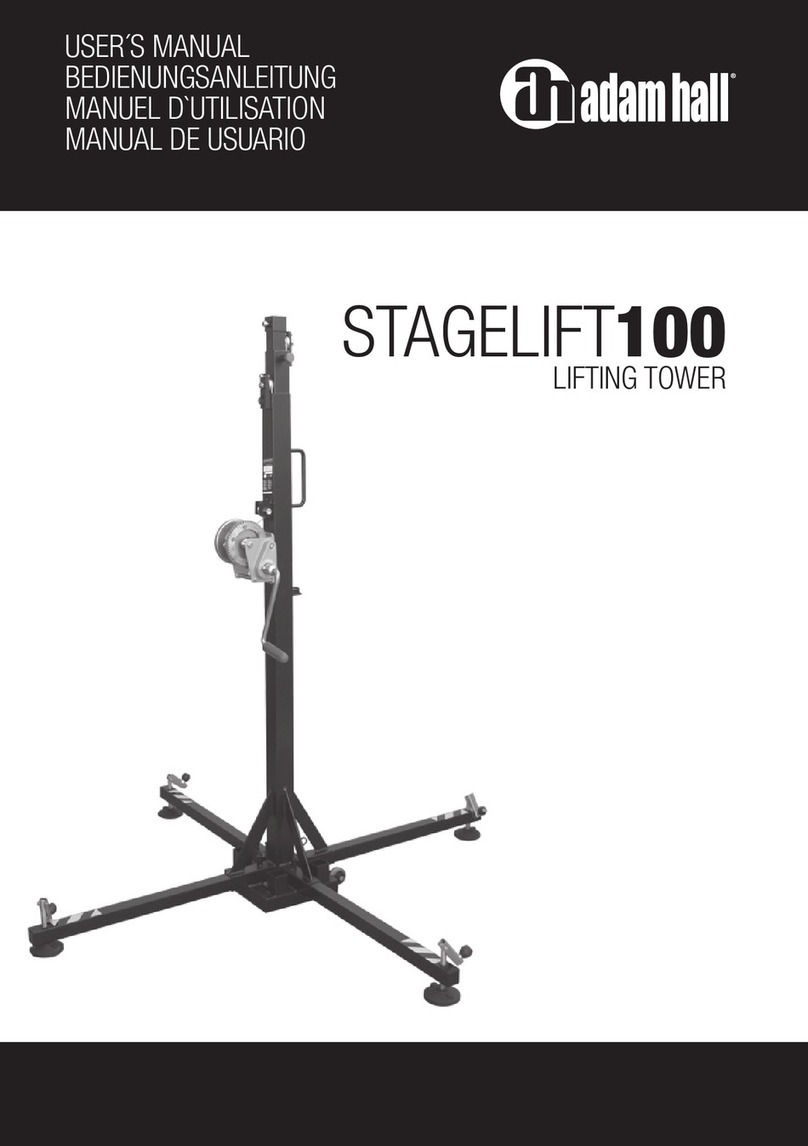
Adam Hall
Adam Hall STAGELIFT100 user manual

Lippert Components
Lippert Components Level-Up owner's manual
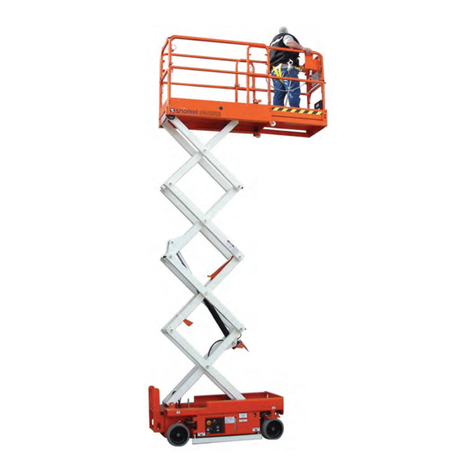
Snorkel
Snorkel S2632E Repair parts manual
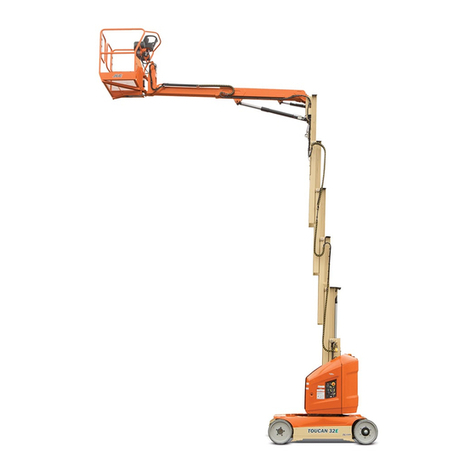
JLG
JLG Toucan 12E Service and maintenance manual

HALDER
HALDER M8 Short instruction manual

Affordable Wheelchair Lifts
Affordable Wheelchair Lifts KCSPM3648 owner's manual

